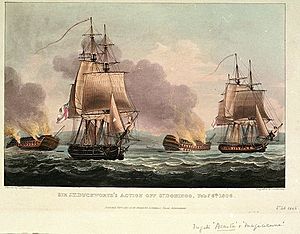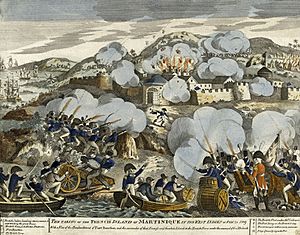Caribbean campaign of 1803–1810 facts for kids
The Caribbean campaign of 1803–1810 was a series of important battles and military actions. These took place mainly in the West Indies (the Caribbean islands) during the Napoleonic Wars. Many European countries were involved, including Napoleonic France, the Batavian Republic (which was like the Netherlands at the time), Spain, the Kingdom of Portugal, and the United Kingdom of Great Britain and Ireland.
Eventually, the British navy became very strong in the seas. By 1810, all the French, Dutch, and Danish colonies in the Caribbean were under British control.
Contents
Why the War Happened
By 1804, France had lost Haiti after a big revolution. They also sold their huge American territory of Louisiana to the United States. But France still had a large colony called Santo Domingo, which they got from Spain.
Islands like Martinique and Guadeloupe were very important for producing sugar. France also had Cayenne in South America. The Dutch, who were allies with France, also had islands and lands in the West Indies.
Main Battles and Actions
Caribbean Campaign 1803
The United Kingdom started its campaign in the Caribbean soon after a peace treaty, the Treaty of Amiens, broke down. Fighting with France began again in May 1803. News of this reached the West Indies in mid-June. The British were ordered to attack France's valuable sugar islands: Martinique, St Lucia, and Tobago.
Martinique was too well defended, so the British commanders, William Grinfield and Samuel Hood, decided to attack the other two islands. Their expedition left Barbados on June 20. They had 3,149 soldiers, two large warships, two smaller warships used for troops, and two sloops.
St Lucia was captured on June 22, 1803. Its main fort, Morne Fortunee, was stormed. Tobago was taken nine days later. After leaving soldiers to protect these new islands, the expedition went back to Barbados.
On August 10, Grinfield received orders to ask the Dutch colonies of Demerara, Essequibo, and Berbice to surrender. These Dutch colonies were not happy with the rule of the Batavian Republic. They had asked the British government for a peaceful takeover. Many of Grinfield's soldiers were now guarding the newly captured French islands. But he added Royal Marines to his force, making it about 1,300 men.
Strong winds made them late, and they arrived off Georgetown on September 18. They immediately sent a message to the Dutch governor. A group arrived on September 20, and they agreed on terms for surrender. Another group had to be sent to Berbice, which was a separate colony. It was taken without a fight on September 27.
Caribbean Campaign 1804
In 1804, the British captured Surinam. The invasion force included Commodore Samuel Hood's main ship, HMS Centaur. Other ships were Emerald, the heavy frigates Pandour and Serapis. There was also the smaller Alligator, the schooner Unique, the corvette Hippomenes, and the Drake. They also had 2,000 soldiers led by Brigadier-General Sir Charles Green.
Reconquista (Santo Domingo)

By this time, Spain, which used to be an enemy of the British and an ally of the French, was invaded by French forces. This led to the Peninsula war in Europe. When the news of the invasion reached the island of Santo Domingo, the local people, called criollos, rebelled against French rule. The British Royal Navy helped them, as Britain and Spain were now allies.
Invasion of the Danish West Indies 1807
In 1807, the British also invaded and took control of the Danish West Indies.
Invasion of Cayenne 1809
By 1808, the French colonies in the Caribbean were causing problems for both the French and British navies. The strong harbors on these islands and coastal towns gave shelter to French warships and privateers. Privateers were like legal pirates who attacked British trade ships. This forced the British Royal Navy to use many ships to protect their convoys.
However, keeping and supporting these French bases was hard for the French Navy. They had lost many battles during the war. Their ships were often trapped in their own harbors, unable to leave without being attacked by British ships. Cut off from French trade and supplies, the Caribbean colonies started to run out of food. Their economies also suffered. Messages were sent to France in 1808 asking for urgent help.
Some of these messages were caught by the British Royal Navy. The messages described how low the spirits were and how weak the defenses were in the French Caribbean lands. So, the British decided to remove the threat from the French colonies for the rest of the war. They planned to capture and occupy them in a series of attacks from the sea.
Rear-Admiral Sir Alexander Cochrane was put in charge of this campaign. He first focused on Martinique. He gathered many ships and men at Barbados to get ready for the invasion. While the main British forces gathered in the Leeward Islands, smaller groups were sent to watch other French colonies.
Invasion of Martinique
The British successfully invaded Martinique in 1809.
Invasion of Guadeloupe
The British then invaded Guadeloupe in 1810.
What Happened Next
The fall of Guadeloupe meant that there were no more French territories left in the Caribbean. The entire region was now controlled by either the British or the Spanish. The only exception was the independent country of Haiti.
With no French privateers or warships around, trade grew very quickly. The economies of the Caribbean islands became strong again. This also greatly reduced French international trade, which hurt the French economy.
Finally, capturing the last French colony was a big blow to the Atlantic slave trade. The British government had made slave trading illegal in 1807. The Royal Navy actively worked to stop it. Without French colonies in the Caribbean, there was no easy place to sell enslaved people in the region. Because of this, the slave trade eventually stopped there.


